
Whitecaps (Peony), 5″ x 7″, wool and acrylic yarns on linen. Designed and hooked by Karen D. Miller, Ottawa, Ontario, Canada, 2016. I get happily lost staring into the chaos of a peony’s bloom. Its hues and shadows roil and boil together like surf on a colorful sea.
More than half of the journey to making art is first seeing it. Once you see it, you can capture it. Often, though, we think that our daily routines are too absorbing to spare moments for wonder. Burdened by the monotony of the everyday, we forget how to be adventurous. Wonder, we say, is for children, as if only children can be carefree and only children can see something for the first time.
Beacon (Thistle), 5″ x 7″, wool and acrylic yarns on linen. Designed and hooked by Karen D. Miller, Ottawa, Ontario, Canada, 2016. The thistle is a forbidding, prickly character who discourages attention. And yet, when I peered in, I discovered an elven kingdom of royal purple. My son was with me, still too young to know that some people have to learn to look past the exterior, to look into the heart, and so unlearn their own blindness.
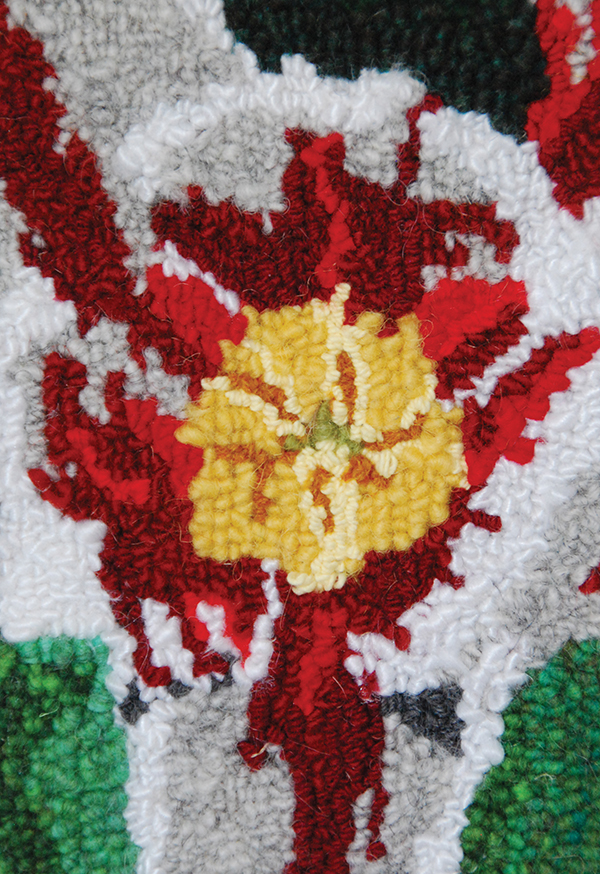
Fireworks (Tulip), 5″ x 7″, wool yarn, acrylic yarn, and cotton yarn on linen. Designed and hooked by Karen D. Miller, Ottawa, Ontario, Canada, 2016. Every year in my city there is a tulip festival. Once upon a time, the tulips were a gift of gratitude from the Netherlands after the war. We are reminded of that fact less often now. Nowadays, I assume, they mean unexplained friendship, an unconditional story that I happen to like better.
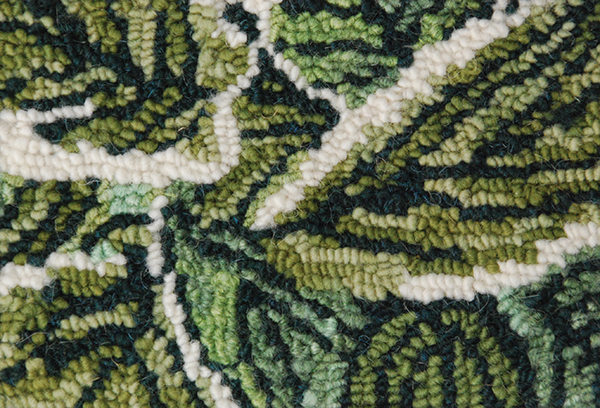
Groundstars (Hosta I), 5″ x 7″, wool yarn on linen. Designed and hooked by Karen D. Miller, Ottawa, Ontario, Canada, 2016. I love hostas, so I planted many in my garden. All green, bluish-green, or striped with cream and white, they splay their colors and rustle in the breeze, flashing like twinkling stars beneath our feet.
I have a garden in my backyard. It isn’t grand by any means, and I have little patience for tending it these days. So it is at times a wild place, beginning right behind my doorstep. Occasionally I get inspired and throw in a new plant, but it is merely throwing an extra splash of color into Mother Nature’s palette. It is her place to play. So I have learned to watch what she does each year. I have learned to observe her living art. I have learned to be amazed.
My favorite method of observation and composition is to focus on the small details—to strip away all of the unnecessary surrounding noise. Technically, the process is straightforward. When you look to the sky, for example, you might take note of the shape of the branches in a tree overhead. When you look down, you might concentrate on moss in the cracks of the sidewalk. You can play with these discoveries using your camera or your sketchbook, and you can experiment with different angles and perspectives. You can zoom in and fill the frame with your subject, and try off-centering it to change the balance. These techniques will make interesting compositions of things that would otherwise be overlooked in a study of the larger landscape.
But they won’t yet be alive. Remember when you were a child and you imagined shapes in the clouds? It was fun because clouds don’t have any shape, so they invite your mind to fill in the blank with a rabbit, or a nose, or a dinosaur. There is no scale; there are no limits.
It is the same with a branch and with moss. Once you have taken the picture, can you cease to think of that image as being of a branch, or of moss, and just treat the colors you see as you did the clouds when you were young? As you hold the picture in your hands, can you just let the forms and the colors become whatever you can imagine them to be? If you can, then you can also do it when you are out in nature, too. When you take the pictures or make the sketches, you will be capturing what you are imagining, not just what the light is showing. You will truly have your own vision of the world.
So please, come with me through my garden. When we step out of my back door, we will step through my viewfinder, my looking glass into Wonderland.
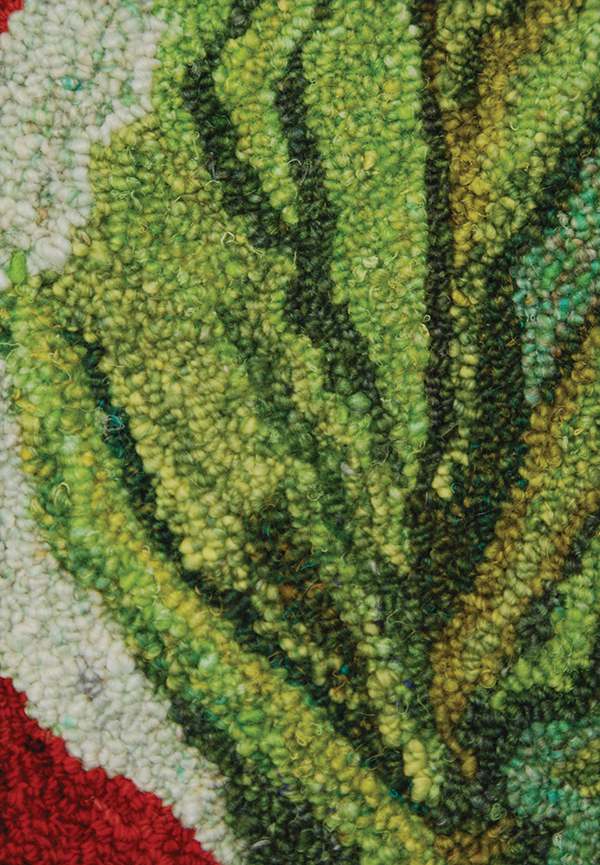
Overflight (Hosta II), 5″ x 7″, wool yarn on linen. Designed and hooked by Karen D. Miller, Ottawa, Ontario, Canada, 2016. Flying low over the surface of its world, I mapped the highways and byways of miniature life.
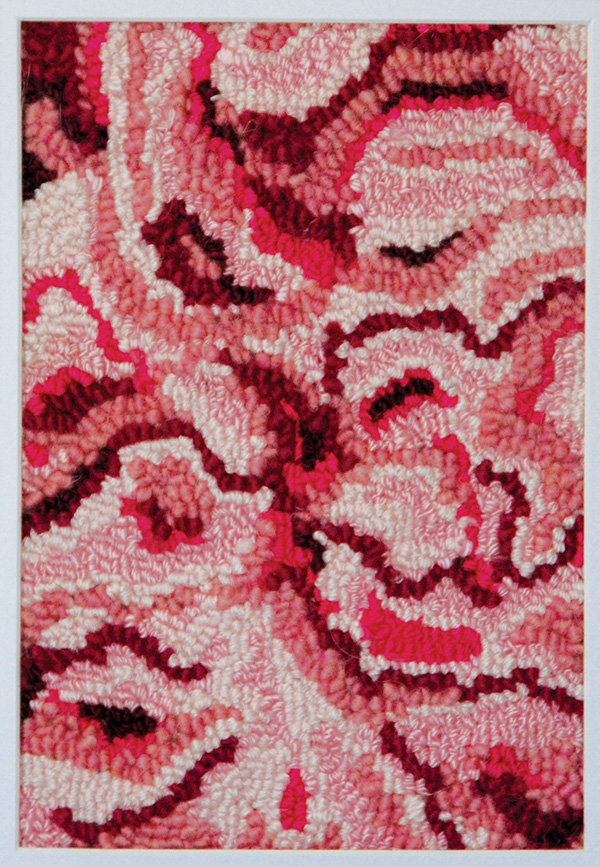
Wisdom (Carnation), 5″ x 7″, wool and acrylic yarn on linen. Designed and hooked by Karen D. Miller, Ottawa, Ontario, Canada, 2017. When I look at a carnation, I see the hand of a loved grandparent. Its complicated beauty is as much to be felt with the gentle brush of a fingertip as it is to be studied by eye, where you will tumble lost into its infinite folds.
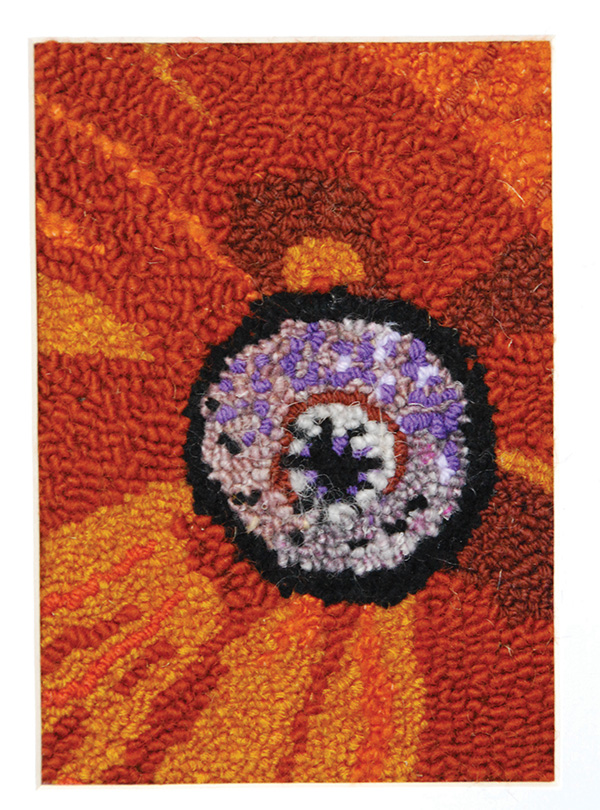
Badge of Honour (Poppy), 7″ x 5″, wool and acrylic yarn on linen. Designed and hooked by Karen D. Miller, Ottawa, Ontario, Canada, 2017. Did you know that a poppy wears its own flower? I didn’t either, until I looked closely at one, right in its center, and said “What’s that?” and it proudly showed me the purple upon its breast.
